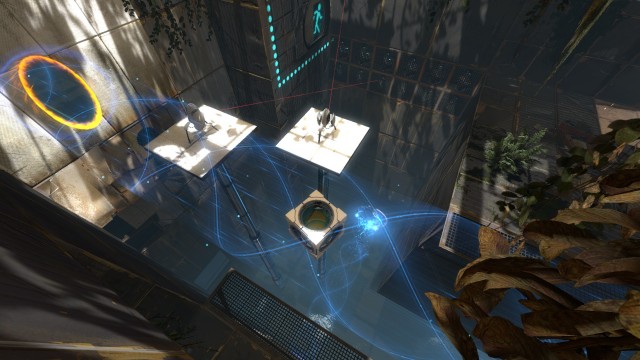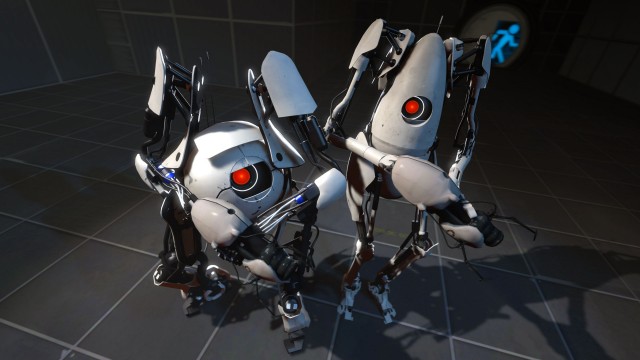
I love mazes.
In elementary school, mazes were always my favorite kind of puzzle. They were simple and helped develop spatial awareness. The goal was simple: get from point A to point B. In this respect, the Portal games are just like mazes. I can see how making a sequel to Portal could be a difficult task. How does a developer make a sequel to a game of mazes? More mazes?
How will Valve go about making a proper sequel to the wildly successful Portal?
After playing Portal 2, Valve’s answer was clear: make sure the player receives a constant stream of new experiences and carefully guide them through these experiences. Following through with these two rules would result in one of the most important gaming experiences on this generation of consoles. Portal 2 is brilliant, and everyone has to play it.
 My solution to a maze was often a jittery, lead-colored line going from “start” to “finish” with a few hints of failed (and promptly erased) paths to a dead end. Still, solving a maze was always satisfying for me because each of my solutions followed the one rule: don’t go through any walls. Valve not only allows you to break this rule through Portal‘s premise, but they also put you in the maze by creating an amalgam of an FPS and a puzzle game.
My solution to a maze was often a jittery, lead-colored line going from “start” to “finish” with a few hints of failed (and promptly erased) paths to a dead end. Still, solving a maze was always satisfying for me because each of my solutions followed the one rule: don’t go through any walls. Valve not only allows you to break this rule through Portal‘s premise, but they also put you in the maze by creating an amalgam of an FPS and a puzzle game.
Your portal gun and testing chamber act as your pencil and maze in Portal 2, just like in its predecessor. In order to freshen things up, Valve provides new tools to help you navigate your way through each testing chamber. These tools allow you to explore (and really appreciate) the physics of the game.
The two most notable mechanic-altering “devices” are the propulsion and repulsion gels. The propulsion gel is orange paint that allows you to run faster across surfaces that happen to be coated in it. The repulsion gel is blue paint that allows you jump higher and bounce off of the surfaces. The fascinating part about the gels is that they actually act as paint. Certain test chambers contain pipes that dispense each type. I was able to coat almost any surface with each gel by placing my portals in the appropriate places, thus giving those surfaces a “bouncy” or “slick” property (depending on which gel you use). I have never had this kind of influence on an in-game environment before and quickly indulged in it by coating almost any surface I could with any type of paint the developers gave me.

Proper guidance must come with new mechanics, and Valve provides it on both “macroscopic” and “microscopic” scales. On a large scale, I always felt like I had company with me in the form of GLaDOS’ taunting and clever remarks. New to the series are Wheatley, another AI character (voiced by Stephen Merchant), and Cave Johnson, Aperture Science’s founder (voiced by J. K. Simmons), who are just as charming as GLaDOS but also provide different flavors of commentary. Their presence helped move the story along and conveyed mood (especially since Chell is a mute protagonist). I rarely felt alone, and none of these “narrators” ever grew stale. GLaDOS, Wheatley, and Cave Johnson do an excellent job of shedding light on the story and add an extra dimension to Portal’s storyline.
Valve provides small-scale guidance by allowing the player to become an active learner in their experience. This requires some slight-of-hand on the part of the developer as each testing chamber teaches you something new about the environment and the game’s mechanics without making the player feel like they were given the solution to a puzzle.
Much like its predecessor, I was never allowed to forget the “lesson” of a previous testing chamber as these techniques would always be required in future areas. For example, the first time you use the orange propulsion gel involves using it to run and jump across a huge pit. One of the following puzzles involved using the gel and portals to launch yourself vertically in the air to hit an out-of-reach button.
I didn’t mind feeling stuck at times because that gave me some incentive to snoop around the environment and appreciate the architecture of each puzzle. Sure enough, I’d find a clue on a wall winking at me and saying, “hey, why don’t you put a portal here?” Every time this happened, I still felt satisfied because this was a form of positive reinforcement, a faint trail of jelly beans leading me to the goal. That was Valve telling me, “You’re onto something! Keep looking!”
Portal 2 excelled in making me feel like the game was communicating with me and allowing me to learn.

New to the Portal experience is a co-op campaign, where you and a friend get to control two of GLaDOS’ robots, P-Body and Atlas. Both are equipped with their own portal guns, allowing the team to create up to four portals at once. Although this does lend itself to more complicated puzzles, two heads are always better than one. Just make sure to have your headsets ready so that you and your friend can brainstorm solutions to each testing chamber. I felt that the difficulty ramped up at a nice pace and that all testing chambers were beyond reasonable, just like the single player experience. I felt that the 4-5 hours I spent completing the co-op campaign far outweighed the 326 hours I’ve spent playing Halo: Reach in terms of meaningful online gameplay.
Portal 2 did not disappoint me. Videogame fans — not just fans of the series –should play this game because it’s an honestly-created video game. Valve had a good concept, they made it come to life in the original Portal, and provided new experiences and proper guidance in its sequel. I constantly felt the care Valve put into creating Portal 2 in its mechanics, writing, and level design. I don’t think you can ask for much more from a developer and its game — except for DLC, that is.
Portal 2 is amazing.
This review of Portal 2 was based on the Xbox 360 version of the game purchased by the reviewer.


2 Comments